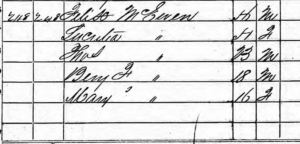 Recently, I was doing some research with the 1850 census and almost missed a 10-year-old child in the family because he was listed on the next page. I’ve developed the good habit of always looking to the next page when the family I’m researching is on the last line of a census page. But in this case, though the family was last, there were two blank lines on the page, so I didn’t bother to click ahead. (That’s a snip of the page at the top of this post.) I’m not sure what caused me to look about a half hour later, but I’m glad I did!
Recently, I was doing some research with the 1850 census and almost missed a 10-year-old child in the family because he was listed on the next page. I’ve developed the good habit of always looking to the next page when the family I’m researching is on the last line of a census page. But in this case, though the family was last, there were two blank lines on the page, so I didn’t bother to click ahead. (That’s a snip of the page at the top of this post.) I’m not sure what caused me to look about a half hour later, but I’m glad I did!
That’s such a easy mistake to make, I thought I’d mention it here. Of course, even if the family you’re researching isn’t the last family on a census page, it’s a good practice to look at the next (and previous) page to observe their neighbors and see whether there are other family members living nearby. Lesson learned!
ETA: I had a feeling that there would be some great comments to this post that would provide additional advice and information and I was right! Please be sure and read the comments. And thank you to those who have commented!

This advice is critical, and sometimes the preceding image applies to what you consider your “target,” too.
The Midwest African American Genealogy Institute (MAAGI) teaches students to look for relatives on several pages before and after our target, especially when our relatives might have changed surnames, possibly due to marriage. How many times have I missed a newly married daughter on the farm next door?
Here are some other places where looking ahead and backward will pay dividends:
When we look at the 2-page-wide pasenger lists, the second page will typically show things like the destination address and person who will meet the passenger.
For the WW2 draft cards, the second side shows some physical description and the date that it was completed. (Sometimes the “second” side precedes the face side in the image series, so check carefully to be sure that it’s the same man.)
In FamilySearch’s images of Ohio death certificates (and possibly other states), an image of the funeral home’s statement to the VA about a veteran’s burial place typically appears just before it in the series.
To file for a delayed birth certificate, typically the applicant had to have several witnesses, and the second side of the form had information about them, like their addresses. Good stuff!
Thank you, Marian, for those great examples of where looking for a second page can really benefit!
Weird about those two blank lines. But yes, definitely check the next page (or previous page) anyway. You just never know what additional ancestors you may find! Or, neighbors that turn out to be important. But it doesn’t always click the first time. Once, early in my research, I was mystified as to why my 2X great grandfather was living as a child with a family of a different surname. Well, it turned out his father had died (actually, he “went to the gold rush and never returned”, but I digress), and his mother married someone else and, of course, took her new husband’s last name. But the plot thickened when I learned her maiden last name and only later (taking another look at the census) realized she was living right next door to her mother and her siblings, with another brother’s family in another neighboring house, and with her new husband listed on the previous census page!
It’s always so interesting to look at documents found early on after you’ve gained more knowledge about your family, isn’t it? Genealogy research is the gift that keeps on giving!
When you check that next or previous page in a census, in addition to looking at the names, be sure to check that the household/family numbers are in the expected sequence. More than once, I have found census pages filmed/digitized out of order, so that additional family members on the real “next” page show up two or more images later, or even *before* the image where the head of household was located. When this happens, I have found that Ancestry will often have indexed people from totally unrelated families, from the bottom of one page and the top of the next out-of-sequence page, as a single “household”. One more reason never to rely on the database “extract”.
Thank you, Kathy! I had never thought to look for the sequence of the household/family numbers! I really appreciate your commenting!
Absolutely! I have found that problem many times on ancestry! Great post.
I totally agree! Some German censuses I work with are one page per person. I always click ahead to see who else is documented in that batch. Specially when it comes to households. And normally there is one overview page at the beginning of the census providing the information how many people are counted… learnt that the hard way, too 🙂
Don’t forget to do this on passenger lists as well. Couples may be traveling separately on the same ship and be listed on different pages.
Great suggestions, Judy. Thanks!